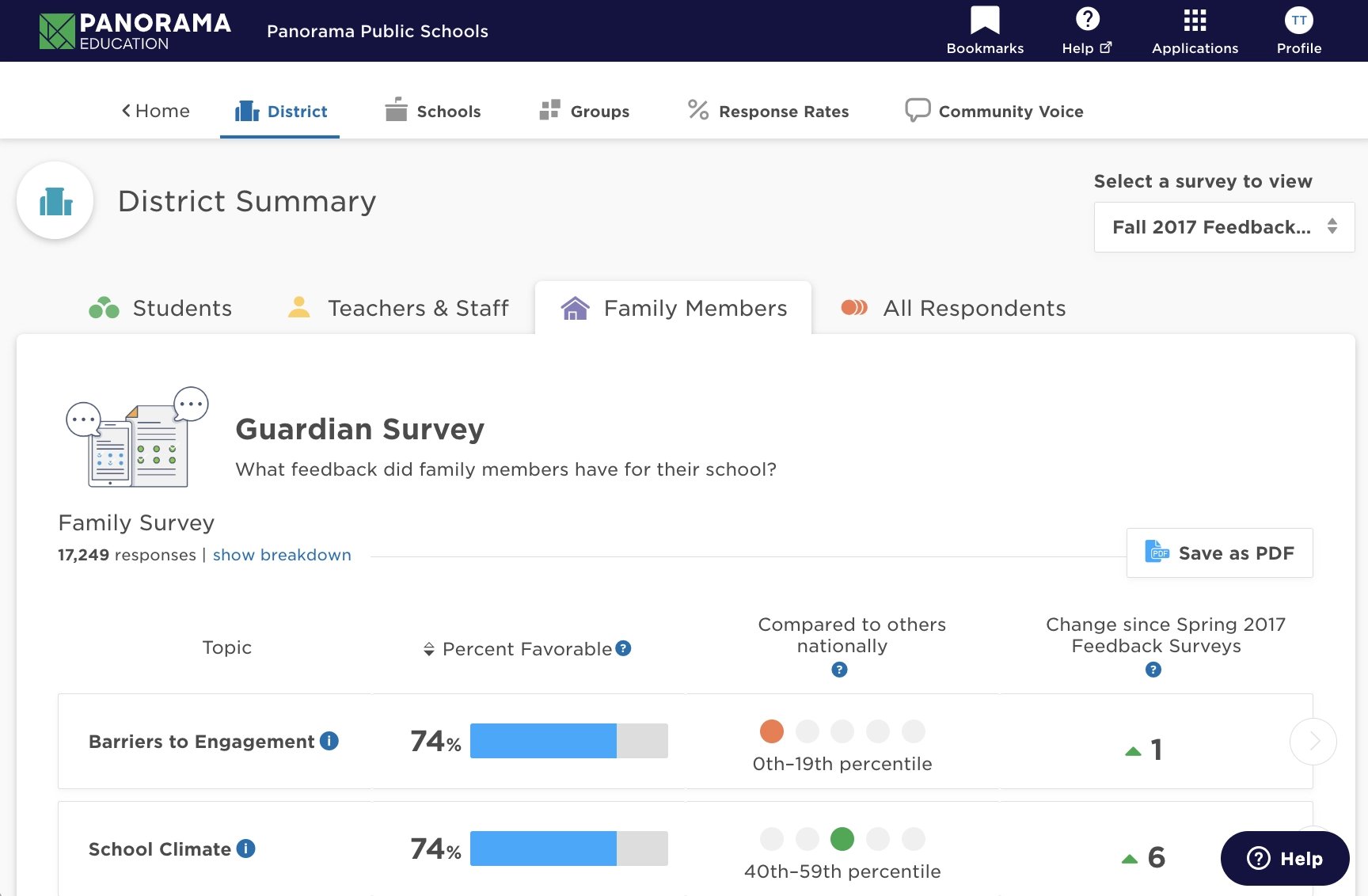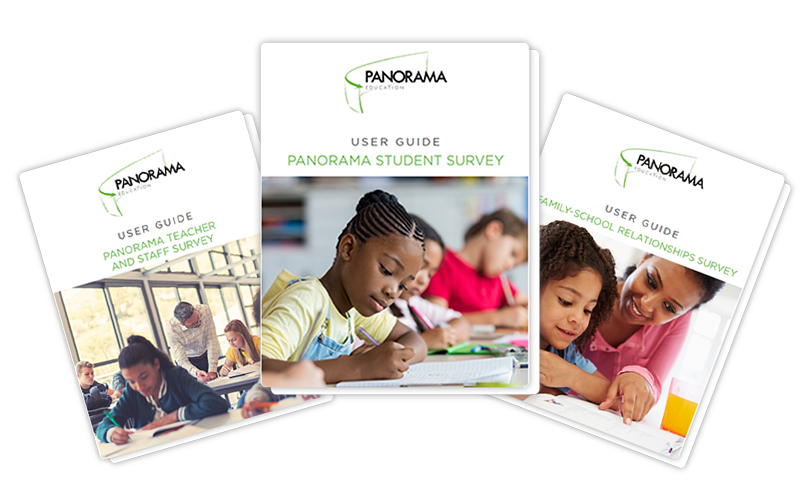Take a moment and imagine a school in your district. How do you feel when you think about this school? Who are the students, teachers, and staff members you see? How do they seem to be feeling?
What’s going on in the classrooms? Think about the physical environment. What does it look like? What posters and signs are on the walls? Do the students and teachers look happy?
All of these pieces work together to create the school climate, a collection of attributes that inform how students, families, faculty, and staff relate to each other and the school itself. While each person may have a different experience, everyone’s actions work together to create the overall character of school life. This can show larger trends within a school district.
In this post, we’ll explore what it means to have a positive school climate. We'll also share some questions you can ask in a school climate survey to gather feedback to make your district a safe and supportive learning environment.
Table of Contents
The Effects of a Positive School Climate
Understanding Community Needs with School Climate Surveys
21 Questions to Ask in a School Climate Survey
Next Steps: Resources for Action
|
Key Takeaways:
|
Gather stakeholder feedback with Panorama’s 360° Climate Surveys
What is School Climate?
School climate refers to the quality and character of school life. According to the National School Climate Council, it is based on student, parent, and school personnel experiences of school life and reflects the norms, goals, values, interpersonal relationships, teaching and learning practices, and organizational structures of a school.
Indicators and staples of a positive school climate include:
- A high level of respect between students and teachers
- A high degree of psychological and physical safety
- Continuous improvement processes to evaluate and iterate on policies and programs
- A shared school vision among caregivers, staff, educators, and students
School climate is often used interchangeably with school culture and school community. While the three terms are related, it’s important to understand how they differ:
- School culture refers to the values, shared beliefs, and behavior of the various stakeholders within a school community. It reflects the school community’s social norms, everyday interactions, and routines. The school culture defines the climate experienced by those in the school community. At the district level, culture includes the experience in the administrative offices, human resources, maintenance, transportation, special services, or any other organizational unit.
- School community refers to all entities that support the activities of the school. Beyond students, teachers, non-instructional staff, and administrators who are active in school buildings, this includes caregivers, volunteers, district-level administrators, paraprofessionals, school board members, and community-serving organizations that work with schools.
The Effects of a Positive School Climate
Decades of research consistently show what educators often see first-hand: a healthy and vibrant school climate leads to better student outcomes in academic achievement, behavior, and relationships. Today, researchers and education leaders consider school climate a key lever for fostering safe, supportive communities.
So how can educators create the conditions necessary for this environment? The National School Climate Center lists the following as the four core components of a positive school climate:
- School safety: Perceptions of students' physical and psychological safety while at school
- Strong relationships: Perceptions of the strength of social connections between teachers and students within and beyond the classroom
- Effective and productive teaching and learning: Perceptions of the quality of teaching and amount of learning students experience
- Healthy, welcoming external school environment: Perceptions of the overall physical, social, and learning environment of the school
By working to improve each of these areas, school and district leaders can create a climate where students, educators, and family members feel safe, seen, supported, and welcomed.
Understanding Community Needs with School Climate Surveys
In order to take meaningful action on school climate improvement, educators need to understand the thoughts, feelings, and experiences of members of the school community.
A school climate survey is a great tool to gather valuable feedback from students, teachers, school staff, and family members. By elevating stakeholder voices, district leaders will gain important insights into the lived experiences of community members. And they'll be able to surface larger trends within the district.

Survey results from Panorama's Family-School Relationships Survey (demo data displayed)
Feedback from surveys gives district leaders important data that can be used to identify areas for growth and plan initiatives and interventions for improving school climate. If your school or district needs help getting started, feel free to download and share our open-source climate survey starter pack. It includes Panorama's complete set of feedback surveys for students, families, and teachers and staff.
Comprehensive Data Integration
In order to take meaningful action on school climate improvement, educators need to understand the feelings, and experiences of members of the school community. But district leaders often face challenges with existing systems that are fragmented and difficult to navigate. Integrating school climate survey data into a unified platform that is able to analyze and manage various types of educational data will simplify admin work and provide real-time access to essential information. School culture surveys provide a wealth of data that, when integrated effectively, offer a complete picture of the school environment.
21 Questions to Ask in School Climate Survey
Based on the four elements of school climate described above, we've highlighted a selection of school climate survey questions for staff, students, and families from three of Panorama’s survey instruments: the Panorama Student Survey, the Family-School Relationships Survey, and the Panorama Teacher Survey. These questions can help you learn about the teacher, staff, family, and student perceptions of school climate.
Questions for Students
- How often does this teacher give you feedback that helps you learn?
- At your school, how much does the behavior of other students hurt or help your learning?
- If you walked into class upset, how concerned would your teacher be?
- How fair or unfair are the rules for the students at this school?
- How often are people disrespectful to others at your school?
- How likely is it that someone from your school will bully you online?
- How positive or negative is the energy of the school?
Questions for Teachers
- How effective is your school's evaluation system at helping you improve?
- How often do you see students helping each other without being prompted?
- On most days, how enthusiastic are the students about being at school?
- How clearly can you explain the most complicated content to your students?
- How often do you meet in person with the families of your students?
- How optimistic are you that your school will improve in the future?
- Overall, how positive is the working environment of your school?
Questions for Families
- To what extent do you think that children enjoy going to your child's school?
- How motivating are the classroom lessons at your child's school?
- Overall, how unsafe does your child feel at school?
- How fair or unfair is the school’s system of evaluating children?
- Overall, how much respect do you think the children at your child's school have for the staff?
- Overall, how much respect to you think the teachers at your child's school have for the children?
- How well do the administrators at your child's school create a school environment that helps children learn?
The Role of Leadership in Shaping School Climate
School leaders set the tone for the school environment by promoting clear expectations, modeling respectful and inclusive behavior, and fostering a shared vision of safety and support. Integrating school climate goals into the overall improvement plan and aligning professional development with these priorities can lead to real, meaningful changes. This proactive approach not only makes the school a better place for everyone but also helps keep great teachers and supports student success.
Effective school leadership involves integrating comprehensive data—academic, behavioral, attendance—into a unified strategy. This approach supports a holistic view of student well-being and achievement. Schools that have systems in place to support vulnerable student populations, create an environment where teachers feel equipped to handle diverse student needs.
School Climate and Teacher Retention
When teachers feel supported, respected, and valued within their school environment, they are more likely to remain in their positions and perform at their best. Educators thrive in environments where they can collaborate with colleagues and have open lines of communication with administration.
A supportive climate fosters strong professional relationships, which are essential for teacher satisfaction. Schools that invest in building a positive climate through professional development, recognition programs, and supportive policies see lower turnover rates and higher levels of teacher engagement.
Student-Led Initiatives for Improving School Climate
Student-led initiatives, such as peer mentoring programs, anti-bullying campaigns, and cultural awareness events, can significantly enhance the school atmosphere. Schools can foster student leadership by providing tools that enable real-time data access and customizable surveys, allowing students to voice their opinions and participate in decision-making processes.
|
Pro Tip: 1. How can schools sustainably integrate school climate improvement efforts into their ongoing practices and initiatives? Schools can integrate school climate improvement efforts into their ongoing practices by embedding them into existing structures and routines. This includes incorporating school climate assessment and goals into the school improvement plan, aligning professional development opportunities with school climate priorities, establishing regular check-ins or meetings to monitor progress on school climate goals, and fostering a culture of continuous improvement where feedback and reflection are valued. 2. What role do students play in shaping and improving school climate, and how can schools empower student voice in this process? Students play a central role in shaping and improving school climate as they are directly impacted by the school environment. Schools can empower student voice by involving students in decision-making processes, creating opportunities for student-led initiatives and projects, establishing student advisory groups or councils, implementing restorative justice practices that prioritize student input and participation in conflict resolution, and providing platforms for students to share their perspectives and experiences through surveys, forums, and assemblies. 3. How can schools foster positive relationships and partnerships with families and community members to support school climate improvement efforts? Schools can foster positive relationships and partnerships with families and community members by creating opportunities for collaboration, communication, and involvement. This may include hosting family engagement events or workshops, establishing parent-teacher organizations or advisory committees, providing resources and support for families to engage in their child's education, partnering with community organizations to provide wraparound services and support, and soliciting feedback from families and community members on school climate priorities and initiatives. |
Next Steps: Resources for Action
Using a school climate survey to collect feedback from family, faculty, staff, and students is an easy way to understand what’s happening district and school-wide. Surveys offer an important opportunity to improve school climate in ways that matter to your community to create a safe and supportive school environment.
Using Technology to Enhance School Climate Surveys
Customizable and interactive survey tools are easy to distribute and complete by students, teachers, and parents. Real-time updates and comprehensive data analytics enable teachers and district leaders to quickly identify and address key issues affecting school climate. Schools using Panorama’s technology have reported meaningful engagement from their communities and actionable insights to improve their school environments.
From our work with schools and districts around the country, we’ve produced a set of resources that will help you meaningfully understand and act on your school climate data. Download the full pack of Panorama’s climate surveys to learn more about collecting high-quality feedback on climate from students, families, teachers, and staff this school year.
Download the full collection of Panorama's open-source climate surveys

.jpeg)




